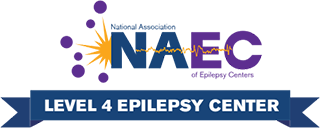
Serving patients with epileptic seizures in Southern California and outside the region
Rady Children’s Comprehensive Epilepsy Center is accredited by the National Association of Epilepsy Centers as a Level 4 Epilepsy Center. Level 4 epilepsy centers have the professional expertise and facilities to provide the highest-level medical and surgical evaluation and treatment for patients with treatment-resistant epilepsy.
Our specialized epileptic seizure team consists of pediatric epileptologists, neurosurgeons, neuroradiologists, neurodiagnostic technologists, nurses and neuropsychologists. Meet our team.
Video: Learn about our comprehensive center
Comprehensive Care
Evaluation
Our EEG laboratory has had ABRET accreditation since 2014 and performs outpatient routine EEGs, outpatient ambulatory EEGs, outpatient video EEGs as well as inpatient video EEGs. Watch a video on our video EEG procedure.
For selected patients who are judged to benefit from a more detailed evaluation, inpatient video EEG monitoring is performed in our hard-wired 6-bed Epilepsy Monitoring Unit where trained nursing staff assists in evaluating patients with seizures according to specified protocols, assuring patient safety and proper assessment during seizure events. Video EEG data is accessible to clinicians through the hospital computer network for review. The goal is to record seizures from children with pediatric epilepsy and attempt to identify a location of seizure onset. This is the first step in evaluating a child for potential epilepsy surgery. Video EEG monitoring is also used to characterize seizures types (ie. epilepsy syndromes) or abnormal behaviors that are concerning for seizures. Video EEG provides informative data that can guide the physician for optimizing treatment.
Pediatric Epilepsy Treatment Options
Epilepsy has many treatment options, and our physicians work with families to design and individualize a treatment plan for each child. Anti-seizure medications for childhood epilepsy are the primary treatments; other treatment options are available depending on the cause of the seizures and/or failure to reduce seizures with two or more anti-seizure medications.
These comprehensive epilepsy treatment options include:
- Ketogenic diet (see patient story), modified Atkins diet (MAD), low-glycemic index diet (LGID)
- Vagal nerve stimulator therapy (an implanted electrical neural stimulation device)
- Deep brain stimulation (an implanted electrical stimulation device that delivers chronic stimulation to the anterior nucleus of the thalamus, a brain structure involved in the spread of a seizure
- Brain responsive neurostimulation (RNS or Neuropace, an implanted electrical stimulation device delivers direct stimulation to the site of the brain causing seizures. It has the ability to monitor the electrical activity in your brain, recognize abnormal activity and deliver small electrical pulse to the seizure evoking region to prevent a seizure from happening
- Surgery (resective or palliative surgery)
- Minimally invasive thermal laser ablation of the epileptogenic focus
Surgical evaluation for children with epilepsy includes:
- Epilepsy specialist evaluation and treatment
- Video EEG monitoring
- Imaging studies performed at Rady Children’s Hospital or outpatient facilities in San Diego:
- 1.5T MRI: An MRI uses magnetic fields to create an image of the brain in order to determine structural abnormalities
- 3T MRI: 3 Tesla refers to the strength of the magnetic field. This scan creates the same three-dimensional images as the standard MRI. 3T MRI also picks up more signals from tissues and may result in clearer, sharper images
- Functional MRI: Measures the changes that take place in the active section of the brain. The patient is asked to perform certain tasks then the correlated area of the brain is studied to identify language, motor and visual areas for surgical planning
- SPECT: Measures blood flow through the various areas of the brain during a seizure, which may be helpful in identifying the area of seizure origin. This procedure is performed at Rady Children’s hospital with Video EEG recording.
- PET: Shows how different areas of the brain use glucose and oxygen, which can be particularly helpful to identify areas of poor function that may indicate the area generating seizures. PET can be performed with sedation if needed and typically is done in conjunction with EEG. The test is performed at the Proton Beam Center in San Diego affiliated with Rady Children’s hospital
- Magnetoencephalography (MEG/MSI): Records the magnetic component of brain waves and shows them on MRI images to identify areas of the brain that generate abnormal electrical activity that may lead to seizures. Areas of important function such as language and motor areas can be identified for surgical planning. This test is performed at University of California San Diego
- Transcranial magnetic stimulation: Used for motor and language mapping and is available at Rady Children’s Hospital
- Neuropsychological testing: In depth functional and cognitive analysis prior to potential surgery. This is performed by one of three neuropsychologists at Rady Children’s Hospital
Throughout the epilepsy treatment journey, our commitment is to provide comprehensive care that goes beyond medication. By integrating a diverse range of therapies, we aim to enhance the quality of life for children with epilepsy and support their families in navigating the complexities of pediatric epilepsy treatment.
Epilepsy Surgery
Upon completion of all recommended studies, the findings are discussed at our multidisciplinary epilepsy conference in order to create an individualized surgical plan. This may include:
- One-stage procedure: Intraoperative electrocorticography (ECOG) followed by surgical resection of the area of seizure origin or minimally invasive thermal laser ablation
- Two-stage procedure: First stage of childhood epilepsy surgery, electrodes are placed on the surface of the brain or into the brain tissue in order to record seizures and identify vital areas for speech, motor function and vision. Second stage includes returning to the operating room for surgical resection of the area of seizure origin or minimally invasive surgery with thermal laser ablation
Our center utilizes a robotic device called ROSA, which has been designed to increase the safety and reliability of neurological procedures. The robot serves as a surgical assistant, acting as a “GPS navigator” for the brain. Read more about ROSA.
Family Support and Education
To provide our patients and families with ongoing support and education, the child’s seizure program partners with the San Diego affiliate of the Epilepsy Foundation of America, which offers expressive arts therapy, parent support groups and family education seminars
Clinical Research Studies
- Detecting seizure and loss of consciousness from eye movements
- A multicenter double-blind randomized placebo controlled parallel group study with open label extension phase of Lorcaserin as adjunctive treatment in subjects with Dravet syndrome
- Efficacy and safety of Vatiquinone for the treatment of mitochondrial disease subjects with refractory epilepsy (MIT-E)
- An evaluation of the use of noninvasive transcranial magnetic stimulation (TMS) in patients experiencing hemiparesis due to stroke, perinatal injury, epilepsy surgery or tumor resection
Patient Stories

Laser ablation significantly reduced Garrett’s seizures. Meet Garrett.
 Thanks to minimally invasive robotic surgery, Lauren’s epilepsy is dramatically improved. Meet Lauren.
Thanks to minimally invasive robotic surgery, Lauren’s epilepsy is dramatically improved. Meet Lauren.
About Epilespy
Epilepsy is a condition we treat and is one of the most common neurological conditions affecting children. The disorder, which causes recurrent seizures, can take many forms and has various causes.
There are 150,000 new cases of epilepsy each year in the United States, and children and the elderly are most at risk for developing the condition.
While significant progress has been made in treating some types of epilepsy, much remains to be done to improve quality of life for people with difficult-to-treat or drug-resistant epilepsy. For children and adolescents, the disorder often causes difficulties in school, uncertainties about social situations and other challenges.
In many people with epilepsy, no cause can be identified. Medical conditions that can lead to epilepsy include:
- Abnormalities of brain development
- Traumatic brain injury/head trauma
- Stroke
- Sequela of infections of the brain such as meningitis/encephalitis
- Genetic conditions
Patient Resources
View these helpful resources below for patients that are visiting our epilepsy center.